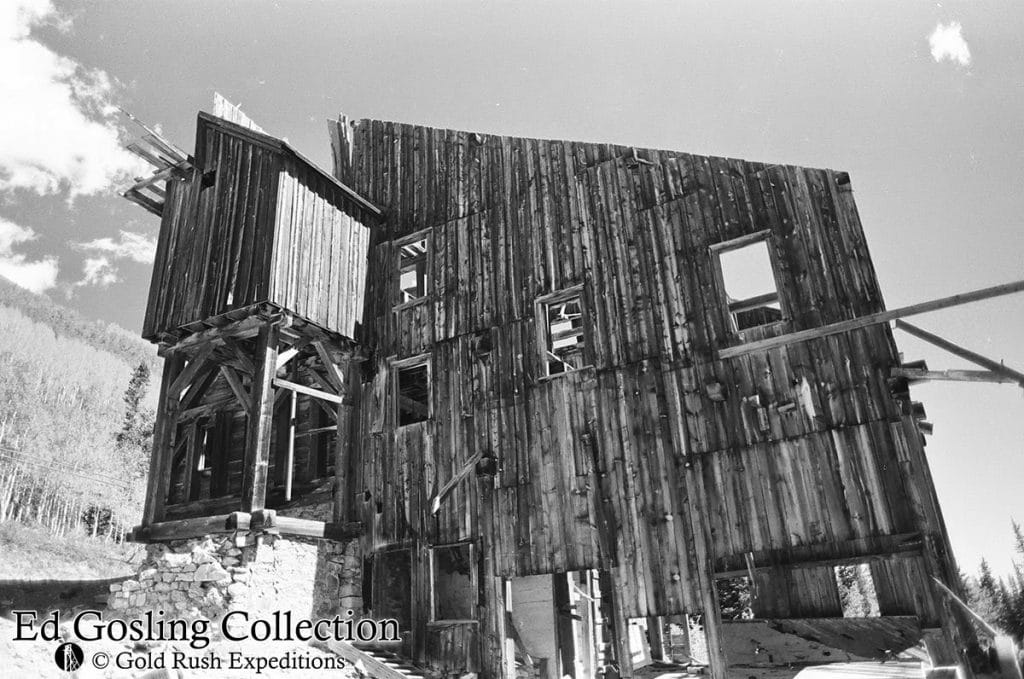Until 1903 when they merged, these were two separately owned adjacent mines on the west side of Thaynes Canyon. The problem with adjacent mines, however, is that there are often disputes over underground theft of ore when the ore vein crosses the claim lines underground. You can imagine the difficulty with underground surveys. Moreover, the provision in federal mining law allows following a vein of ore if it dips out the end line, but not if it dips out the side lines made disputes the order of the day.
The California Mine consisted of about 8 claims lying south and west of the present Comstock-California Mill alongside the current Keystone trail at Park City Mountain. With only dirt wagon roads in Thaynes Canyon, it was difficult to transport the heavy loads of ore produced here. In order to concentrate the ore before shipping, the owners purchased the Apex Mill in 1900, moved it across the canyon and refitted it with updated machinery. In 1897, the owners incorporated the California Mine on four of the claims with Wilson Snyder as one of the incorporators. In the early 1900s, the California Mine consisted of the small Apex mill, an office and a shop. There were two tunnels, one at the creek level and one about 100’ above. There was also a shaft on the hillside about 185’ deep. Underground workings had progressed to include about 1000’ of tunnels and drifts plus a stope on a vein of ore about 500’ long. Blacksmith and carpenter shops, a tunnel house and magazine were in place with about ½ mile of steel rails.
The Comstock Mine, lying just north of the California, was presumably unable to secure domestic funding for operation, so it was incorporated in London in 1882 with four claims: Comstock, Black Bear, Intervention and Black Hawk with a capitalization of £250,000 at 1 share per pound. In 1890 the Comstock included a boarding house for 50 men, a blacksmith shop, carpenter shop and an office. At that time there were two tunnels and the company was preparing to sink a shaft served by a whim.
Work proceeded apace at the Comstock and by 1901 there was a 450’ deep shaft, hoisting equipment, an office and a boarding house, with a tunnel at the creek level 2000' long. The shaft connected to the tunnel at the 250' level by an incline raise. Some of the ore was so pure it could be shipped directly to the smelter, but much of it required concentrating in the 120-ton modern mill at the site. The shaft was a sturdy one with 3 compartments, all timbered with 12" x 12" timbers. Water pumped from the shaft was used both in the milling process and to make steam to power the mill equipment.
However, the California Mine was heavily in debt and facing foreclosure by the National Bank of Park City. The California was also threatening to sue the Comstock mine for underground theft of ore. An underground inspection discovered that the most valuable ores lay within the California claims so the directors and managers of the two mines agreed to merge the two mining companies share for share with 600,000 total shares, creating the Comstock & California Consolidated Mining Company.
As of June 15, 1905, new company had been capitalized at $1,000,000 with shares $1 each and the new board elected: President H.A. McCornick, Vice-President Wilson Snyder, Treasurer S.A. Whitney, Secretary Gideon Snyder.
For more than 12 years, the Comstock & California mine continue to produce ore in Thaynes Canyon. By 1917, however, the company was ripe for acquisition. Both the Silver King Coalition and the King Con had their eye on the property. The King Con won the bidding war and took over the Comstock & California on January 31, 1918. Solon Spiro was busy digging the Spiro Tunnel to drain the King Con properties and access new bodies of ore. With the Comstock California claims in the eventual path of Spiro tunnel, it was an ideal acquisition.
King Con modernized and enlarged the old mill and installed new equipment which remains today in remains today in Thaynes Canyon. Unfortunately, the King Con faced decreasing metal prices after WWI and on May, 1924, they were forced to sell their 1400 acres of surface rights, shafts and the tunnels and mine workings of the Spiro, Bogan Shaft and Comstock & California for $600,000 to the Silver King Coalition.
Saving the California Comstock Mill
The second project undertaken by Friends of Ski Mountain Mining History was the iconic California Comstock Mill in Thaynes Canyon. It was often photographed for promotional uses because it was such an unusual sight at a ski resort. This project stretched over parts of 2 years with the process of replacing beams and reconstructing crumbling masonry. With an enormous crane, the construction crew was able to lift a mechanical crusher weighing many tons from the basement where it had fallen through layers of flooring.
Engineering: Jonathan Richards, Calder Richards Consulting Engineers
Construction: Clark Martinez, Xcavation Company
Cost: $124,196
Before and After
Learn More by Reading These "Way We Were" Articles:
A Jolly Jaunt to Brighton by Mahala Ruddel







